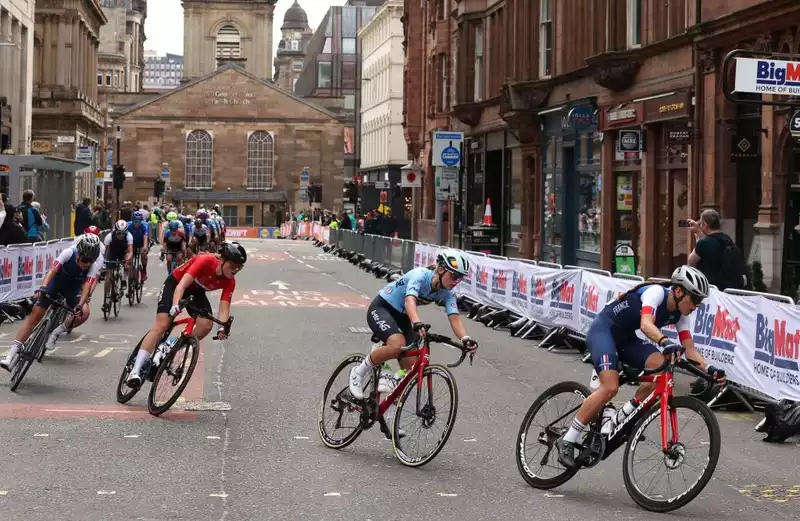The UCI Road World Championships kicked off on Saturday with the junior men's and women's road races, with France's Julie Bego and Denmark's Albert Philipsen the lone winners and the first rainbow jerseys in the Glasgow road races.
These two races are for under-18s, and because of their short distances, they do not cover the 120 km from Edinburgh to the Glasgow circuit. However, there were many indicators of how the elite men's race would unfold.
Cycling News covered Glasgow's 14.3km city circuit and what tactics, mishaps, and mayhem could be seen on the ground on Sunday.
The 14.3 km circuit has 43 corners, which is quite a lot for a road race and more like an American criterium than a normal road world championship course. This is a very large number for a road race, more akin to an American criterium than a normal road world championship course.
The turns and large peloton are incompatible, and the fact that the UCI allowed the Glasgow organizers to use barricades with feet protruding into the road rather than flat feet will exacerbate the problem.
There were several falls in the junior women's race and it was difficult to count how many athletes fell in the junior men's race. The races may be a battle of attrition, but it is inevitable that crashes will have a significant impact on the outcome.
After watching the junior men's race, the elite men's team must have come to the conclusion that there was little merit in continuing the race. Breaking up the peloton and taking chances from a small lead group seems a much better option.
There are few climbs on this circuit tough enough to separate the Classics riders, and after 10 laps, the much-discussed Montrose Road climb is unlikely to bother the serious World Tour sprinters. Teams can push out the bigger riders on the Crow Road climb. At 5.6 km long, the current Strava section record is 11:24 set by Michael Stohler (who unfortunately did not make the Australian team for the World Championships).
The average gradient on Crow Road is 4.8%, but there is a very steep section of about 500 meters on the way up.
If the peloton is split on the climb, there is 20.4 km for the riders to chase, but a concerted effort by several major teams could be realized, or with enough motivated riders, it could be cleared by the sneaky actions of opportunists-- Ben Healy (Ireland), Derek Gee (Canada), Toms Skudzinish (Latvia), or former world champion Michał Kwiatkowski (Poland).
Riders who do not have a team that can control the chaotic circuit should try to make a foray there.
As demonstrated in the junior women's race, there are other opportunities to get away besides the controversial Montrose Avenue climb. Though steep, the climb is only 200 meters, and Ellen van Dijk has the fastest time of 20 seconds on this section.
Junior men's world champion Albert Philipsen left the breakaway group behind on Montrose Street and gained a decent lead.
A rider like Mathieu van der Pol might have a chance if he goes on this climb, but a surprise attack could decide the race, as when Julie Bego attacked on the short Eldon Street climb on the back side of the course in the junior women's race.
With so many turns and teams not allowed to use race radios, it is very difficult to know exactly what is going on. Attacks can be made at any section, and there are no straights long enough to check ahead.
As van der Pol said after the preview run, the key on Sunday will be to be careful and make the right moves.
The many turns on this course make it difficult to keep the support cars close to all the racers in case of mechanics or mishaps. In the junior women's race around the Glasgow circuit, the leader was seen almost catching up to the back of the support car train from the back of the race pack.
The many corners and climbs mean that there are few places for support cars to stop and hand riders new bikes and wheels. This means that recovering from a puncture is very difficult, especially in the final stages.
Again, since the riders are supported by national teams rather than by their year-round trade teams, they may not have the same staff familiarity with quick changeovers that is found in major World Tour races such as the Tour de France or the Spring Classics. There is no such thing.
.

Comments